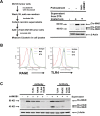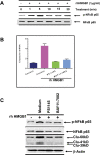HMGB1 induction of clusterin creates a chemoresistant niche in human prostate tumor cells
- PMID: 26469759
- PMCID: PMC4606829
- DOI: 10.1038/srep15085
HMGB1 induction of clusterin creates a chemoresistant niche in human prostate tumor cells
Abstract
Development of chemoresistance, especially to docetaxel (DTX), is the primary barrier to the cure of castration-resistant prostate cancer but its mechanism is obscure. Here, we report a seminal crosstalk between dying and residual live tumor cells during treatment with DTX that can result in outgrowth of a chemoresistant population. Survival was due to the induction of secretory/cytoplasmic clusterin (sCLU), which is a potent anti-apoptotic protein known to bind and sequester Bax from mitochondria, to prevent caspase 3 activation. sCLU induction in live cells depended on HMGB1 release from dying cells. Supernatants from DTX-treated DU145 tumor cells, which were shown to contain HMGB1, effectively induced sCLU from newly-plated DU145 tumor cells and protected them from DTX toxicity. Addition of anti-HMBG1 to the supernatant or pretreatment of newly-plated DU145 tumor cells with anti-TLR4 or anti-RAGE markedly abrogated sCLU induction and protective effect of the supernatant. Mechanistically, HMGB1 activated NFκB to promote sCLU gene expression and prevented the translocation of activated Bax to mitochondria to block cell death. Importantly, multiple currently-used chemotherapeutic drugs could release HMGB1 from tumor cells. These results suggest that acquisition of chemoresistance may involve the HMGB1/TLR4-RAGE/sCLU pathway triggered by dying cells to provide survival advantage to remnant live tumor cells.
Figures






Similar articles
-
Induction of clusterin by AKT--role in cytoprotection against docetaxel in prostate tumor cells.Mol Cancer Ther. 2010 Jun;9(6):1831-41. doi: 10.1158/1535-7163.MCT-09-0880. Epub 2010 May 25. Mol Cancer Ther. 2010. PMID: 20501799 Free PMC article.
-
Clusterin knockdown using the antisense oligonucleotide OGX-011 re-sensitizes docetaxel-refractory prostate cancer PC-3 cells to chemotherapy.BJU Int. 2008 Aug;102(3):389-97. doi: 10.1111/j.1464-410X.2008.07618.x. Epub 2008 Mar 11. BJU Int. 2008. PMID: 18336596 Clinical Trial.
-
Clusterin over-expression modulates proapoptotic and antiproliferative effects of 1,25(OH)2D3 in prostate cancer cells in vitro.J Steroid Biochem Mol Biol. 2007 Mar;103(3-5):721-5. doi: 10.1016/j.jsbmb.2006.12.068. Epub 2007 Jan 16. J Steroid Biochem Mol Biol. 2007. PMID: 17224269
-
Clusterin and chemoresistance.Adv Cancer Res. 2009;105:77-92. doi: 10.1016/S0065-230X(09)05005-2. Adv Cancer Res. 2009. PMID: 19879424 Free PMC article. Review.
-
Secretory Clusterin: A Promising Target for Chemoresistance of Hepatocellular Carcinoma.Mini Rev Med Chem. 2020;20(12):1153-1165. doi: 10.2174/1389557520666200331072122. Mini Rev Med Chem. 2020. PMID: 32228422 Review.
Cited by
-
The role of TLR-4 in chemoresistance of cancer.Discov Oncol. 2025 May 22;16(1):865. doi: 10.1007/s12672-025-02509-z. Discov Oncol. 2025. PMID: 40404908 Free PMC article. Review.
-
HMGB1 enhances chemotherapy resistance in multiple myeloma cells by activating the nuclear factor-κB pathway.Exp Ther Med. 2021 Jul;22(1):705. doi: 10.3892/etm.2021.10137. Epub 2021 May 2. Exp Ther Med. 2021. PMID: 34007314 Free PMC article.
-
Mechanisms involved in the HMGB1 modulation of tumor multidrug resistance (Review).Int J Mol Med. 2023 Aug;52(2):69. doi: 10.3892/ijmm.2023.5272. Epub 2023 Jun 30. Int J Mol Med. 2023. PMID: 37387415 Free PMC article.
-
Role of pattern recognition receptors in chemotherapy-induced neuropathic pain.Brain. 2024 Mar 1;147(3):1025-1042. doi: 10.1093/brain/awad339. Brain. 2024. PMID: 37787114 Free PMC article.
-
Exposure of vital cells to necrotic cell lysates induce the IRE1α branch of the unfolded protein response and cell proliferation.Cell Stress Chaperones. 2018 Jan;23(1):77-88. doi: 10.1007/s12192-017-0825-6. Epub 2017 Jul 7. Cell Stress Chaperones. 2018. PMID: 28687980 Free PMC article.
References
-
- Borst P., Jonkers J. & Rottenberg S. What makes tumors multidrug resistant? Cell cycle 6, 2782–2787 (2007). - PubMed
-
- Patterson S. G. et al. Novel role of Stat1 in the development of docetaxel resistance in prostate tumor cells. Oncogene 25, 6113–6122 (2006). - PubMed
-
- Parczyk K., Pilarsky C., Rachel U. & Koch-Brandt C. Gp80 (clusterin; TRPM-2) mRNA level is enhanced in human renal clear cell carcinomas. J Cancer Res Clin Oncol 120, 186–188 (1994). - PubMed
-
- Steinberg J. et al. Intracellular levels of SGP-2 (Clusterin) correlate with tumor grade in prostate cancer. Clin Cancer Res 3, 1707–1711 (1997). - PubMed
MeSH terms
Substances
Grants and funding
LinkOut - more resources
Full Text Sources
Other Literature Sources
Medical
Research Materials

